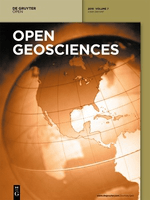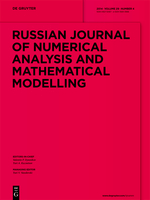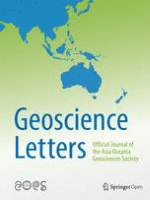
Mathematical Geosciences
Scope & Guideline
Unlocking Earth’s Mysteries through Mathematical Insights
Introduction
Aims and Scopes
- Geostatistical Modeling:
The journal extensively covers geostatistical methods to analyze spatial data, focusing on uncertainty quantification, spatial interpolation, and the simulation of geological variables. - Machine Learning and Data-Driven Approaches:
There is a strong emphasis on the application of machine learning techniques for mineral prospectivity mapping, geochemical anomaly detection, and geological modeling, showcasing the integration of computational intelligence in geoscience. - Numerical Simulation and Optimization:
Research involving numerical methods for simulating subsurface flow, thermal energy storage, and other geological processes is prevalent, reflecting the journal's commitment to solving real-world geoscience problems. - Environmental and Resource Management:
The journal addresses issues related to the sustainable management of natural resources, including water quality assessment, mineral resource evaluation, and the impact of mining on the environment. - Interdisciplinary Approaches:
Mathematical Geosciences encourages interdisciplinary research that combines mathematics, geology, hydrology, and environmental science to tackle complex geological phenomena.
Trending and Emerging
- Deep Learning Applications:
There is a significant increase in papers utilizing deep learning techniques for various applications, including mineral prospectivity mapping, geochemical pattern recognition, and seismic data analysis, highlighting the transformative impact of AI in geosciences. - Uncertainty Quantification:
Research focusing on uncertainty quantification in geostatistical modeling and geological simulations is trending, emphasizing the importance of understanding and managing uncertainty in geoscience applications. - Integration of Remote Sensing and Geostatistics:
The combination of remote sensing data with geostatistical methods is emerging as a popular theme, reflecting the need for comprehensive data analysis in geological and environmental studies. - Hybrid Modeling Techniques:
There is an increasing trend towards hybrid models that integrate traditional geostatistical methods with modern machine learning approaches, showcasing a shift towards more robust analytical frameworks. - Environmental Impact Assessments:
Growing attention is being paid to the environmental impacts of mining and resource extraction, with studies focusing on monitoring and mitigating these effects through advanced modeling techniques.
Declining or Waning
- Traditional Statistical Methods:
There is a noticeable decrease in the publication of papers focusing solely on traditional statistical methods without integration into modern computational frameworks or machine learning, suggesting a shift towards more advanced analytical techniques. - Basic Geological Mapping Techniques:
Research centered on conventional geological mapping and characterization techniques seems to be waning, possibly due to the rise of more sophisticated technologies such as remote sensing and machine learning. - Hydrological Modeling Without Advanced Techniques:
Studies on hydrological modeling that do not incorporate advanced computational methods or machine learning approaches are becoming less frequent, indicating a trend toward more innovative methodologies.
Similar Journals

COMPUTATIONAL GEOSCIENCES
Exploring the Intersection of Geosciences and ComputationCOMPUTATIONAL GEOSCIENCES, published by SPRINGER, is a distinguished journal in the fields of Computational Mathematics, Computational Theory and Mathematics, and Computer Science Applications. With a focus on the intersection of computational methodologies and geosciences, this journal serves as a vital platform for researchers, professionals, and students seeking to advance the understanding and application of computational techniques in earth sciences. The journal has consistently maintained a strong standing, evident from its impressive Q2 quartile ranking in 2023 across various categories, and significant Scopus rankings in Computational Mathematics and Earth and Planetary Sciences. The global impact of this journal is underscored not only by its rigorous peer-review process but also by its commitment to disseminating high-quality research that bridges theoretical advances and practical applications within the earth sciences domain. Scientifically rich and culturally diverse, COMPUTATIONAL GEOSCIENCES aims to foster collaboration and innovation while addressing pressing challenges posed by our changing planet, making it an essential resource for the academic community.

Open Geosciences
Innovating Discussions in Environmental Science.Open Geosciences, published by DE GRUYTER POLAND SP Z O O, is a prominent open access journal that has been serving the scientific community since its inception in 2015. With an ISSN of 2391-5447, this journal focuses on the dynamic fields of Earth and Planetary Sciences as well as Environmental Science, securing a commendable Q2 ranking in both categories as of 2023. Situated in Germany, Open Geosciences is committed to disseminating high-quality research and facilitating innovative discussions surrounding geosciences. The journal embraces a diverse range of topics, aiming to foster collaboration among researchers, professionals, and students worldwide. As an open access publication, it enhances visibility and accessibility of its articles, allowing for greater engagement within the global scientific community. This is further substantiated by its respectable Scopus rankings—77th out of 195 in General Earth and Planetary Sciences and 97th out of 219 in Environmental Science—which underscore its significance in advancing geoscientific knowledge. Whether you are a researcher looking to publish your findings or a student seeking valuable insights, Open Geosciences stands out as a crucial resource in the exploration of our planet and its environment.

Acta Geodynamica et Geomaterialia
Connecting Earth Sciences with Engineering ExcellenceActa Geodynamica et Geomaterialia is a well-regarded journal published by the Academy of Sciences of the Czech Republic, Institute of Rock Structure and Mechanics. Since its inception in 2004, this journal has established itself as a vital resource within the realms of Geology, Geophysics, and Geotechnical Engineering, categorized in the Q3 quartile across these fields as of 2023. With a focus on innovative research that addresses complex Earth dynamics and material behavior, it provides a platform for scholars and professionals to disseminate their findings and foster academic discourse. The journal holds an important position in the academic landscape, particularly for those engaged in interdisciplinary studies bridging geology and engineering. Although it is not an open access publication, its content remains pivotal for advancing knowledge and practices within these areas, making it an essential read for researchers and students alike. The journal's operational address is located in the vibrant city of Prague, Czech Republic, further enriching its academic character.

Frontiers in Applied Mathematics and Statistics
Fostering Collaboration for Global Research ImpactFrontiers in Applied Mathematics and Statistics is a premier open-access journal published by FRONTIERS MEDIA SA, dedicated to advancing the fields of applied mathematics and statistics. Launched in 2015 and based in the scenic city of Lausanne, Switzerland, this journal fosters robust academic discourse by providing a platform for high-quality research that bridges theoretical understanding and practical application. With a current ranking of Q3 in both the Applied Mathematics and Statistics and Probability categories, it has rapidly gained visibility within the academic community, positioned at the intersection of theory and application. This journal not only encourages contributions from a diverse array of disciplines but also ensures that research is freely accessible to a global audience, fostering collaboration and innovation. Available online under a fully open-access model, Frontiers in Applied Mathematics and Statistics continues to play a vital role in disseminating critical insights and methodologies to researchers, professionals, and students who seek to expand their knowledge and drive progress in these essential fields.

RUSSIAN JOURNAL OF NUMERICAL ANALYSIS AND MATHEMATICAL MODELLING
Fostering Excellence in Numerical Research and SimulationRUSSIAN JOURNAL OF NUMERICAL ANALYSIS AND MATHEMATICAL MODELLING, published by WALTER DE GRUYTER GMBH in Germany, is a vital resource for researchers and practitioners in the fields of numerical analysis, mathematical modeling, and computational mathematics. With an ISSN of 0927-6467 and an E-ISSN of 1569-3988, this journal has been disseminating significant findings since its inception in 1986 and continues to do so into 2024. Despite its current position in Q4 category quartiles and modest Scopus rankings, it provides a platform for innovative research that contributes to the evolution of modeling and simulation techniques. The journal is committed to fostering an understanding of complex numerical methods and their applications across various scientific disciplines. Although it does not provide Open Access options, it remains a key publication that underscores the importance of rigorous mathematical analysis and its practical implications in today's technology-driven world.

Bulletin of Computational Applied Mathematics
Empowering Innovations in Computational MathematicsThe Bulletin of Computational Applied Mathematics, published by UNIV SIMON BOLIVAR, is an esteemed open-access journal dedicated to the fields of Applied and Computational Mathematics. Since its inception in 2013, this journal has provided a platform for researchers, professionals, and students to share innovative findings and methodologies that advance mathematical theory and application. With its ISSN 2244-8659, the bulletin has carved a niche in the academic community, maintaining a focus on practical computational issues while fostering the dissemination of research that aligns with contemporary challenges in the discipline. As reflected in its Scopus rankings and categorization within Q4 in both Applied and Computational Mathematics, the journal serves as a vital resource for those seeking to stay informed of the latest breakthroughs and trends. Based in Venezuela, the journal reflects a commitment to open access, ensuring that knowledge is readily available to a global audience, thus enhancing collaborative efforts in these critical mathematical domains.

Advances in Applied Mathematics and Mechanics
Transforming Ideas into Solutions for Real-World ChallengesAdvances in Applied Mathematics and Mechanics is a premier academic journal published by GLOBAL SCIENCE PRESS that focuses on the latest research and innovative developments in the fields of applied mathematics and mechanical engineering. Since its inception in 2009, this journal has consistently contributed to the advancement of knowledge, garnering a respectable Q2 ranking in both Applied Mathematics and Mechanical Engineering categories, reflecting its significance in enhancing scientific discourse. With an impactful reach, as evidenced by its Scopus rankings, this journal hosts cutting-edge research, theoretical advancements, and practical applications that serve as invaluable resources for researchers, professionals, and students alike. While it operates under a subscription model, the accessibility of vital research findings is critical for driving innovation within these interrelated disciplines. The journal’s scope encompasses a broad range of topics, from computational methods to engineering applications, positioning it as a crucial platform for interdisciplinary collaboration and knowledge sharing in an ever-evolving academic landscape. For prospective authors and readers, Advances in Applied Mathematics and Mechanics stands as a key contributor to confidently navigating the nexus of applied mathematics and mechanics.

COMPUTATIONAL MATHEMATICS AND MATHEMATICAL PHYSICS
Bridging Mathematics and Physics through Innovative ResearchCOMPUTATIONAL MATHEMATICS AND MATHEMATICAL PHYSICS is a prestigious journal published by PLEIADES PUBLISHING INC, dedicated to advancing the fields of computational mathematics and mathematical physics. With an ISSN of 0965-5425 and an E-ISSN of 1555-6662, the journal has established its importance within the academic community since its inception in 1985. It is classified in the third quartile (Q3) for computational mathematics in 2023, and while currently it does not offer open access options, it remains a valuable resource for researchers seeking to disseminate their findings and engage with cutting-edge developments in the field. The journal encompasses a broad spectrum of topics, including numerical analysis, applied mathematics, and the intersection of physics and computational techniques, highlighting its relevance in addressing complex problems in both theoretical and applied contexts. Scholars will find a platform that not only promotes rigorous research but also encourages collaboration and innovation within the scientific community.

Applied Earth Science-Transactions of the Institutions of Mining and Metallurgy
Transforming Earth Science Discoveries into Industry SolutionsApplied Earth Science - Transactions of the Institutions of Mining and Metallurgy, published by SAGE Publications Inc, is a vital academic journal located in the United Kingdom that seeks to illuminate the intricate relationship between earth sciences and the mining and metallurgy industries. With an ISSN of 2572-6838 and an E-ISSN of 2572-6846, the journal features peer-reviewed research encompassing various subfields such as Geochemistry, Petrology, and Geotechnical Engineering. As an open-access journal, it ensures that cutting-edge findings are readily available, promoting broad access to knowledge crucial for professionals, researchers, and students alike. With its convergence of research years from 2018 to 2024, the journal maintains a Q3 ranking in Earth and Planetary Sciences and Q4 rankings in Geochemistry and Petrology as well as Geotechnical Engineering, which demonstrates its emerging influence in these disciplines. The journal not only provides a platform for innovative research but also addresses practical challenges faced within the field, making it essential reading for those engaged in the applied earth sciences.

Geoscience Letters
Pioneering Open Access in Earth SciencesGeoscience Letters, published by Springer, is a prominent open-access journal in the field of Earth and Planetary Sciences, recognized for its dedication to advancing knowledge and research in this vital area of study. With a reported impact factor that reflects its esteemed position—ranking in the Q1 quartile of Earth and Planetary Sciences, particularly as the journal ranks #48 out of 195 in the general category according to Scopus—the journal serves as a vital resource for researchers, professionals, and students. Since its inception in 2014, Geoscience Letters has facilitated the dissemination of high-quality research and critical insights, aiming to bridge the gap between scientific discovery and societal needs. Its commitment to open access ensures that the latest findings are readily available to a global audience, thus enhancing collaboration and innovation within the geosciences community.